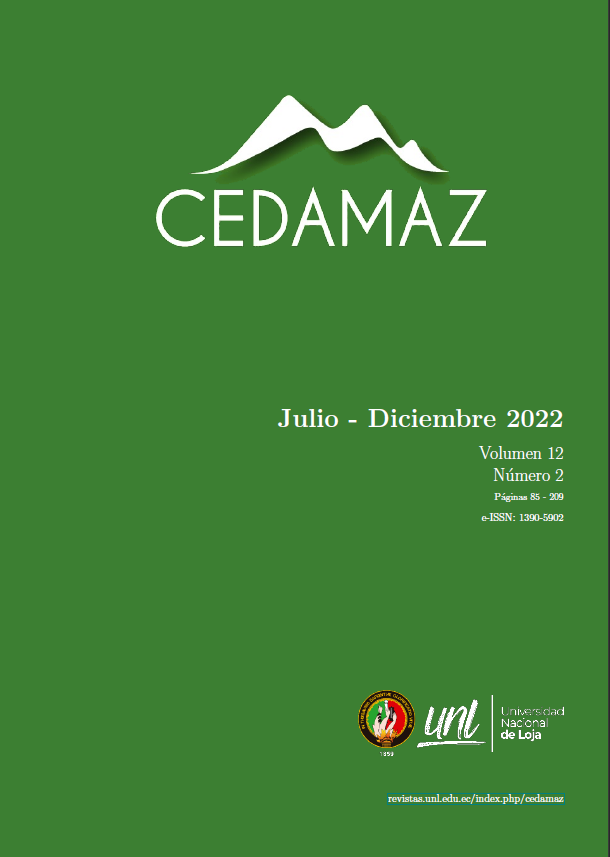Optimization of photovoltaic systems for the Yuwints community in eastern Ecuador
DOI:
https://doi.org/10.54753/cedamaz.v12i2.1603Abstract
Abstract—Access to electricity for isolated communities in the east of the Republic of Ecuador has become a milestone, so government entities are looking for alternatives for electrification being the most viable electrification through SFV, which is why electricity distribution companies including CENTROSUR with the Yantsa li Etsari program that means light of our sun, These systems serve as a basis for analysis and reference, which is why the rural community of Yuwints in eastern Ecuador has been taken as a case study. The research includes a study of the demand for electricity in the community’s homes based on an on-site survey. The tabulation of the survey shows the energy information, the geographic distribution of the houses and other results such as the topology of the site that leads to (clusters) grouping the houses in five groups. The algorithm uses the linear integer optimization (LIP) tool that includes energy demand and location data. As a result of the optimization, the center of mass and voltage drop is found for each cluster, thus locating the location of the microgrids. If the algorithm does not perform any clustering, it means that the house must be energized by an individual system or it can keep the existing one.References
Agustín, C., y Apolo, A. (2017). Exploration of renewable sources for isolated systems. AIE. (2017). World Energy Outlook 2017 – Análisis - AIE.
Andrade, Monroy-G, J. D., Valencia, E., y Noriega, J. (s.f.). Corpoica Ciencia y Tecnología.
Arrow, G. (1931). The coleopterous genus Trichillum (Copridae), with a key to the species. The Annals and Magazine of Natural History, 10(8), 609–611. doi: https://doi.org/10.1080/00222933108673452 DOI: https://doi.org/10.1080/00222933108673452
Bárcena, A., Samaniego, J., Galindo, L. M., Carbonell, J. F., Alatorre, J. E., Stockins, P., Mostacedo, J. (s.f.). La economía del cambio climático en américa latina y el caribe. una visión gráfica.
Centrosur. (2020). Proyectos fotovoltai Cos con nuevas regulaciones. – Centrosur.
CONELEC. (2009). Atlas solar del ecuador.
Dolors, C. (2019). El proceso normativo ante el avance tecnológico y la transformación digital. Revista General de Derecho Administrativo 50.
Domenech, B., Ferrer-Martí, L., García, F., Hidalgo, G., Pastor, R., y Ponsich, A. (2022). Optimizing pv microgrid isolated electrification projects—a case study in ecuador. Mathematics, 10. doi: 10.3390/math10081226 DOI: https://doi.org/10.3390/math10081226
Dursun, B., y Aykut, E. (2019, aug). An investigation on wind/PV/fuel cell/battery hybrid renewable energy system for nursing home in Istanbul. Proceedings of the Institution of Mechanical Engineers, Part A: Journal of Power and Energy, 233(5), 616–625. Descargado de http :// journals .sagepub.com/doi/10 .1177/0957650919840519 doi: 10 .1177/0957650919840519 DOI: https://doi.org/10.1177/0957650919840519
Flores, L. E. U. (2015). Procedimiento para la electrificación en zonas aisladas: Caso cantÓn taisha, morona santiago.
G de Brito, M. A., Poltronieri Sampaio, L., Galotto Jr, L., Canesin, C., Aureliano Gomes de Brito, M., Galotto, L., Member, S. (2012). Evaluation of MPPT techniques for photovoltaic applications Evaluation of the Main MPPT Techniques for Photovoltaic Applications. DOI: https://doi.org/10.1109/ISIE.2011.5984303
GAD. (2022). gobierno autónomo de morona Santiago Búsqueda de Google.
Greene, N., y Mendoza, V. (2020). Policy paper: Diagnóstico sobre las energías renova- bles en el mundo, Ecuador y Perú. , 38.
Holt. (2020). Appendix a matlab ’ s optimization toolbox. doi: 10.1007/978-3-319-65919-0
Ploskas, N., y Samaras, N. (2017). Appendix a matlab ’ s optimization toolbox. doi: 10.1007/978-3-319-65919-0 DOI: https://doi.org/10.1007/978-3-319-65919-0
Quituisaca, P. (2015). Modelo de gestiÓn sostenible de proyectos de electrificaciÓn rural aislada mediante energÍas renovables – aplicaciÓn al caso centrosur.
Scinergy. (2020). Mapa solar del Ecuador.
Published
How to Cite
Issue
Section
License
Copyright (c) 2022 CEDAMAZ

This work is licensed under a Creative Commons Attribution-NonCommercial-NoDerivatives 4.0 International License.
Those authors who have publications with this journal, accept the following terms:
- After the scientific article is accepted for publication, the author agrees to transfer the rights of the first publication to the CEDAMAZ Journal, but the authors retain the copyright. The total or partial reproduction of the published texts is allowed as long as it is not for profit. When the total or partial reproduction of scientific articles accepted and published in the CEDAMAZ Journal is carried out, the complete source and the electronic address of the publication must be cited.
- Scientific articles accepted and published in the CEDAMAZ journal may be deposited by the authors in their entirety in any repository without commercial purposes.
- Authors should not distribute accepted scientific articles that have not yet been officially published by CEDAMAZ. Failure to comply with this rule will result in the rejection of the scientific article.
- The publication of your work will be simultaneously subject to the Attribution-NonCommercial-NoDerivatives 4.0 International (CC BY-NC-ND 4.0)









